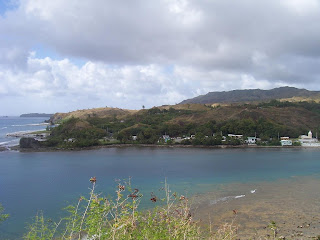It's been two years since I've posted on my blog! I'll spare you my list of reasons and just say, Hafa Adai! I'll get re-started with a few scribbles from 2010...so far.
JANUARY-FEBRUARY
This year began on January 7 when I headed back to the States for my twice-yearly visit with family and friends. The photos and personal narrative below might give you a feel for that trip.
Maui--I took a boat trip to hunt for whales and sea turtles. Saw them both! Durham--Mother (87) & Dad (85) are still going strong!
Phoenix--The 2004 Cruise Reunion: Carrie, Jorie, me, Vaughn
Kuaui—The Resort Experience
Travel Musings
A Wheelchair at the Airport? You Bet!*
Katherine Shaw is like most of us—she doesn’t want to focus on her MS all the time. So when a friend offered to get her a wheelchair at the airport, her immediate reaction was anger. (“The Funny Page: Would You Just Shut Up?” Momentum, Spring 2010). Of course beneath her anger was fear of the future, a future when she might need a wheelchair. I can still walk, so understand that fear. Still, I think she’s wrong about a wheelchair at the airport. You see, I discovered I had MS in the
No, there’s not a neurologist’s office or an MRI machine there, but an experience in that airport pushed me to find out what was wrong with my right leg. It was March 2007. My daughter’s wedding was planned for July. I was living in
I sitting at my gate when the announcement came over the intercom: our flight had been changed to a different terminal. I was tired, but I’m an experienced hiker with seven trips into the
By that time I’d been limping for a couple of years. The first time I reported the trouble, I’d just returned from a two-week driving and hiking trip to
As I walked through the airport, I found myself moving more and more slowly, and not only because I was tired. No matter how hard I pushed myself, I couldn’t pick up the pace. As I became increasingly frustrated, I realized I wasn’t limping at all: my right leg was dragging. My left leg was doing all the work, and only the bag rolling on my right was keeping me from falling over. I made that flight—just before the gate agent closed the door. As soon as I got home, I went to see my doctor a third time. As calmly as I could, I explained what had happened in the airport. Then I insisted she find out what was going on with my leg. Two more doctors, a physical therapist, and an MRI later, I had my diagnosis: secondary progressive MS.
I’m still walking. These days I use two hiking poles to keep my balance and compensate for the right leg that still drags. I don’t own a wheelchair (yet), and I resist using them in stores. Airports, however, are an entirely different matter. These days air travel depends on physical stamina, excellent balance, and the ability to walk quickly. Ironically, then, riding in a wheelchair actually allows me to focus less on my MS in an airport. Then there are the perks: meeting the interesting, courageous folks who push those wheelchairs, getting through security more easily, and being seated first on the airplane.
After three years and eight more airplane trips, I’m truly grateful for a wheelchair at the airport. Whenever I make an air reservation, I request one. I ask for the chair at curbside check-in, and I make sure the gate agent knows I need one when I reach my destination. So why not use a wheelchair at the airport? For my money, it’s the only way to fly!
*(submitted for publication to Momentum, the magazine of the National MS Society; no word yet)
MARCH
March is “Chamorro Month” on
The journal of Pigafetta, a Venetian scholar who accompanied Magellan on his history attempt at circumnavigating the globe for the sole purpose of keeping accurate records tells a different story, however. As he tells the story, on March 6, 1521 Magellan sailed not into
It’s interesting to note here that Pigafetta’s journal first came to light in English translation in 1906, so the history’s been around more than 100 years ago. In 1969, another flurry of scholarly activity led to an even more accessible translation of the journal. Beginning then educators have made a serious attempt to set the record straight here on
Folklore 1; History 0.
Lest we get too comfortable in our superiority over the locals, I have another example for you:
St. Patrick’s Day also happens in March. Think for a moment what you believe about
True or False? St. Patrick taught about the trinity using the shamrock.
Unknown: Bishop Patrick was a missionary in Ireland in the late 300s. Only two of his letters have survived, neither of which say anything about his teaching methods.
True or False? The traditional color for St. Patrick is green.
False: The color for St. Patrick was blue for 1300 years. Only in the last 200 years as green became associated with Irish nationalism did the color for St. Patrick’s Day change—primarily in the
True or False? Corned beef and cabbage is a traditional Irish meal.
True for cabbage; False for corned beef: The Irish ate bacon with cabbage. They exported corned beef to
.
True or False? St. Patrick’s most famous miracle was driving the snakes out of
False: Snakes are not native to
Folkore 4; History 1
If you think about it, the line separating folklore from history is pretty thin sometimes. From our very informal survey, it seems that folklore tends to triumph over history. For one thing, it’s more fun. For another, it keeps us comfortable. In this time of such loud certainty on both sides of the aisle, then, it’s probably important to hold our most basic assumptions lightly. Who knows if those “facts” are folklore or history?
APRIL
I offer you an Easter poem I wrote a few years back but still like...
THE THIRD DAY
When it was time for Christ
(so wholly human) to battle
his way out of God-forsaken hell back
to sunshine-blue middle earth, did Archangel
Michael lower Jacob's ladder again from
somewhere beneath David's star that shone
so brightly just thirty-three years before?
As the Good Shepherd
(who calls his sheep by name) climbed
with labored determination through layers of
man-made darkness, were the rungs of that splintered
ladder so slippery with blood that he had to
cling with both shredded hands whenever one
shredded foot missed its mark?
When it was time for Jesus
(so wholly divine) to come out
of his borrowed tomb, did he get up from
that cold slab and fold his linen shroud
neatly, precisely the way his mother Mary
taught him, leaving it ready for the next
visitor who would happen by?
As the Logos
(who is and was and will be) pushed
and shoved the stone until it finally
rolled away, did he have to put his raw
carpenter's back into it so he could step
out into birdsong morning and wait
for us to remember the plan?
Wonderful Counselor, Mighty God,
Everlasting Father, Prince of Peace,
Emmanuel,
welcome back
to our lives.







2 comments:
Beautiful, introspective, insightful and inspiring. Blessings, peace and joy for your eveyday. Bette
Suzanne, I love your blog, and I love your Easter poem. It's a beautiful example of inspired, original work and the depiction of what this day means is beautiful and the questions beg of answers from my own heart about our Savior on His resurrection.
Post a Comment